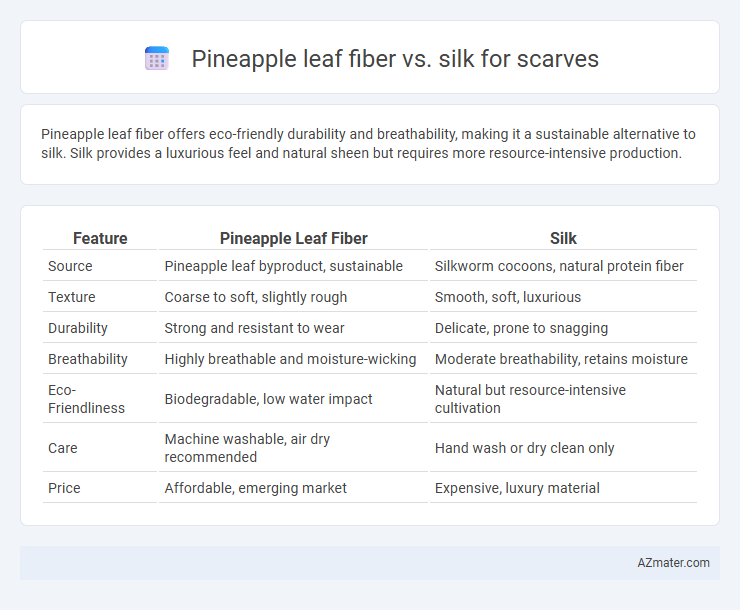Pineapple leaf fiber offers eco-friendly durability and breathability, making it a sustainable alternative to silk. Silk provides a luxurious feel and natural sheen but requires more resource-intensive production.
Table of Comparison
| Feature | Pineapple Leaf Fiber | Silk |
|---|---|---|
| Source | Pineapple leaf byproduct, sustainable | Silkworm cocoons, natural protein fiber |
| Texture | Coarse to soft, slightly rough | Smooth, soft, luxurious |
| Durability | Strong and resistant to wear | Delicate, prone to snagging |
| Breathability | Highly breathable and moisture-wicking | Moderate breathability, retains moisture |
| Eco-Friendliness | Biodegradable, low water impact | Natural but resource-intensive cultivation |
| Care | Machine washable, air dry recommended | Hand wash or dry clean only |
| Price | Affordable, emerging market | Expensive, luxury material |
Introduction to Pineapple Leaf Fiber and Silk
Pineapple leaf fiber, derived from the extracted fibers of pineapple plant leaves, offers a sustainable and eco-friendly alternative for textile production, notably for scarves, with a natural sheen and lightweight texture. Silk, a luxurious natural protein fiber produced by silkworms, is prized for its smoothness, luster, and strength, making it a classic choice in high-end scarf manufacturing. Both fibers provide distinct tactile and aesthetic qualities, with pineapple leaf fiber emphasizing sustainability and texture, while silk highlights elegance and softness.
Origins and Production Methods
Pineapple leaf fiber, derived from the leaves of the Ananas comosus plant native to the Philippines, is extracted through a labor-intensive decortication process that separates fibers before washing and drying, producing a sustainable, eco-friendly textile. Silk originates from the cocoons of the Bombyx mori silkworms, primarily farmed in China and India, where the fibers are carefully reeled and spun into fine threads through a delicate boiling and unwinding method. Both fibers offer unique textures: pineapple leaf fibers provide a coarse, matte finish ideal for rustic designs, while silk delivers a smooth, lustrous fabric favored for luxury scarves.
Environmental Impact and Sustainability
Pineapple leaf fiber scarf production utilizes agricultural waste, significantly reducing environmental impact by minimizing deforestation and chemical use compared to silk, which relies heavily on mulberry cultivation and the labor-intensive rearing of silkworms. Pineapple leaf fiber processing requires less water and energy, contributing to lower carbon emissions and promoting circular economy principles through fiber extraction from discarded leaves. Silk, while biodegradable and naturally sourced, often involves intensive water consumption and pesticide use, making pineapple leaf fiber a more sustainable option for eco-conscious scarf manufacturing.
Texture and Feel: A Sensory Comparison
Pineapple leaf fiber offers a coarse yet pleasantly crisp texture with a natural matte finish, providing a rustic and breathable feel ideal for eco-conscious fashion. Silk delivers an exceptionally smooth, soft, and lustrous touch, known for its luxurious drape and hypoallergenic properties that enhance comfort against the skin. Choosing between them depends on the desired sensory experience: pineapple leaf fiber emphasizes durability and organic texture, while silk prioritizes softness and elegance in scarves.
Durability and Longevity
Pineapple leaf fiber (PALF) scarves exhibit exceptional durability due to their high tensile strength and natural resistance to wear and tear, making them ideal for long-term use. Silk scarves, while prized for their luxurious texture and sheen, are more delicate and susceptible to damage from abrasion and environmental factors, resulting in a shorter lifespan. For longevity and consistent durability, pineapple leaf fiber outperforms silk, especially in everyday wear conditions.
Breathability and Comfort
Pineapple leaf fiber offers exceptional breathability and moisture-wicking properties, making it ideal for lightweight, comfortable scarves that keep the skin cool and dry. Compared to silk, pineapple fiber is more durable and environmentally friendly, while silk provides a smooth, luxurious feel with moderate breathability but less moisture absorption. Choosing between the two depends on prioritizing natural breathability and sustainability (pineapple leaf fiber) versus softness and sheen (silk) for scarf comfort.
Color and Dye Affinity
Pineapple leaf fiber offers excellent dye affinity, absorbing vibrant and long-lasting colors due to its natural cellulose content, which creates a strong bond with dyes. Silk, composed of protein fibers, exhibits superior color brilliance and smoothness, resulting in rich, lustrous hues that enhance the scarf's visual appeal. While pineapple leaf fiber maintains colorfastness and resists fading, silk provides a softer, more luminous finish with a wide range of dye options.
Price and Market Availability
Pineapple leaf fiber scarves are generally more affordable than silk scarves due to lower production costs and abundant raw materials sourced from pineapple agriculture byproducts. Silk scarves command higher prices because of expensive sericulture processes and limited availability, especially for high-quality varieties like mulberry silk. Market availability of pineapple leaf fiber scarves is expanding in sustainable fashion sectors, while silk scarves dominate luxury and traditional markets worldwide.
Fashion Trends and Aesthetic Appeal
Pineapple leaf fiber scarves offer a sustainable and textured alternative to traditional silk, increasingly favored in eco-conscious fashion circles for their unique matte finish and natural durability. Silk scarves maintain a timeless elegance with their smooth, lustrous surface and vibrant color retention, aligning with classic luxury fashion trends. Both materials bring distinct aesthetic appeals: pineapple leaf fiber emphasizes organic, rustic charm, while silk delivers sophisticated sheen and fluid drape, influencing scarf choices in modern accessory styling.
Choosing Between Pineapple Leaf Fiber and Silk Scarves
Pineapple leaf fiber scarves offer eco-friendly, biodegradable, and durable qualities with a slightly coarse texture and natural matte finish, ideal for sustainable fashion enthusiasts. Silk scarves deliver a luxurious, smooth feel with vibrant sheen and excellent breathability, making them perfect for elegant, high-end styling. When choosing between the two, consider sustainability and texture preferences versus softness and traditional luxury to select the best scarf material for your wardrobe.

Infographic: Pineapple leaf fiber vs Silk for Scarf
 azmater.com
azmater.com